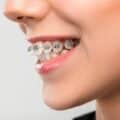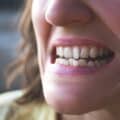Can Invisalign Correct an Underbite? A Complete Guide
Have you ever wondered if your underbite could be corrected without traditional metal braces? Many people are turning to Invisalign as a discreet and comfortable alternative. But does it actually work for underbites?
Let’s explore what an underbite is, how Invisalign works, and whether it’s a suitable option for you.
Understanding Underbites
An underbite occurs when your lower jaw juts out further than your upper jaw. It can make your teeth look misaligned and your facial features appear out of balance.
There are two main types of underbites:
- Class III underbite: This is the most common type, where the lower front teeth overlap the upper front teeth.
- Horizontal underbite: In this case, the lower jaw is positioned too far forward, but the teeth may not overlap.
Underbites can be caused by a variety of factors, including:
- Genetics: If your parents or other family members have underbites, you’re more likely to develop one as well.
- Jaw development: Problems with the growth and development of your jaws can contribute to an underbite.
- Habitual thumb-sucking or pacifier use: These habits can affect the way your teeth and jaws align.
- Injury or trauma: Damage to your jaw or teeth can lead to an underbite.
How Invisalign Works
Invisalign uses a series of clear, removable aligners to gradually straighten your teeth. These aligners are custom-made to fit your mouth perfectly and are designed to gently shift your teeth into their correct positions over time.
The Invisalign treatment process typically involves:
- Initial consultation: Your orthodontist will assess your teeth and jaw to determine if you’re a good candidate for Invisalign.
- Impression taking: Your orthodontist will take impressions of your teeth to create a digital model that will be used to design your aligners.
- Aligner creation: Your aligners will be fabricated in a laboratory using advanced 3D printing technology.
- Treatment progression: You’ll receive a series of aligners, each one slightly different from the last. You’ll wear each aligner for a certain period of time, typically 1-2 weeks.
- Regular check-ups: Your orthodontist will monitor your progress and make any necessary adjustments to your treatment plan.
Invisalign offers several advantages over traditional metal braces, including:
- Discreetness: Invisalign aligners are virtually invisible, making them a great option for people who want a more aesthetically pleasing treatment.
- Comfort: Invisalign aligners are made from smooth, comfortable materials, and they don’t have any sharp edges or wires to irritate your mouth.
- Convenience: Invisalign aligners are removable, so you can eat, drink, and brush your teeth as normal.
- Shorter treatment time: In some cases, Invisalign treatment can be completed in a shorter amount of time than traditional braces.
Can Invisalign Correct Your Underbite?
While Invisalign is a great option for many people with underbites, it’s important to understand that not all cases can be corrected with this treatment alone. Several factors can influence the effectiveness of Invisalign for underbite correction:
- Severity of the underbite: Mild to moderate underbites are more likely to be successfully treated with Invisalign. However, severe underbites may require a combination of Invisalign and other treatments, such as jaw surgery.
- Patient’s age and facial growth: Invisalign is most effective for adults with fully developed facial features. For adolescents who are still growing, additional treatments or monitoring may be necessary to ensure proper jaw development.
- Other underlying dental issues: If you have other dental problems, such as crowded teeth or missing teeth, these may need to be addressed before or during your Invisalign treatment.
Despite these factors, many people with underbites have achieved excellent results with Invisalign. Here are some case studies:
- Case study 1 – Mild Underbite: Joan (name changed), a young woman with a mild underbite was able to successfully correct her bite using Invisalign. Her treatment took about 18 months, and she was very pleased with the results.
- Case study 2 – Severe Underbite: Adam (name changed), a man with a more severe underbite combined Invisalign with jaw surgery to achieve a healthy and balanced bite. The surgery was followed by a period of Invisalign treatment to refine the final alignment of his teeth.
Advantages of Invisalign for Underbite Correction
Invisalign offers several key advantages over traditional metal braces for people with underbites:
- Discreet and aesthetic appeal: Invisalign aligners are virtually invisible, making them a great option for people who want to avoid the metal wires and brackets associated with traditional braces. This can be especially important for adults and teenagers who are concerned about their appearance.
- Improved comfort and convenience: Invisalign aligners are made from smooth, comfortable materials and are removable, allowing you to eat, drink, and brush your teeth as normal. This can make the treatment process much more convenient and less painful than traditional braces.
- Easier oral hygiene maintenance: With Invisalign, you can easily remove your aligners to brush and floss your teeth. This can help prevent gum disease and tooth decay, which are common problems for people with underbites.
- Shorter treatment time in some cases: In certain cases, Invisalign treatment can be completed in a shorter amount of time than traditional braces. This can be a significant benefit for people who want to achieve a straighter smile as quickly as possible.
Potential Challenges and Limitations
While Invisalign offers many benefits, it’s important to be aware of the potential challenges and limitations:
- Treatment duration and frequency of aligner changes: The length of your Invisalign treatment will depend on the severity of your underbite and your individual treatment plan. You’ll typically need to change your aligners every 1-2 weeks, which can require some commitment and planning.
- Compliance and adherence to the treatment plan: To achieve optimal results, it’s essential to wear your Invisalign aligners for the recommended amount of time each day. If you don’t wear your aligners as directed, your treatment may take longer, and you may not achieve the desired results.
- Cost of Invisalign treatment: Invisalign can be more expensive than traditional metal braces. However, many insurance plans now offer coverage for orthodontic treatments, including Invisalign. It’s important to check with your insurance provider to see if you’re eligible for reimbursement.
- Possible need for additional procedures: In some cases, Invisalign may not be sufficient to fully correct an underbite. You may need to undergo additional procedures, such as jaw surgery or extraction of teeth, to achieve the desired results.
Alternatives to Invisalign
If you’re not a suitable candidate for Invisalign, or if you prefer a more traditional treatment option, there are other alternatives available:
- Traditional metal braces: Metal braces are a tried-and-true method for correcting underbites. They use brackets and wires to gradually move your teeth into alignment. While they may be less aesthetically appealing than Invisalign, they are often more affordable and can be effective for severe underbites.
- Surgical intervention: In some cases, jaw surgery may be necessary to correct a severe underbite. This procedure involves moving the jawbones into a more balanced position. Jaw surgery is typically followed by orthodontic treatment to refine the alignment of the teeth.
Choosing the Right Underbite Treatment Option
When deciding between Invisalign and other treatment options for your underbite, it’s crucial to consult with an orthodontist who can assess your individual needs and recommend the best approach.
During your consultation, your orthodontist will:
- Examine your teeth and jaw: They will assess the severity of your underbite and identify any other dental issues that may need to be addressed.
- Discuss your treatment goals: Your orthodontist will ask about your expectations for the treatment and how you envision your smile.
- Explain the different treatment options: They will outline the benefits and drawbacks of each option, including Invisalign, traditional braces, and surgical intervention.
- Provide a personalized treatment plan: Based on your individual needs and preferences, your orthodontist will develop a customized treatment plan that addresses your specific concerns.
When evaluating the different treatment options, it’s important to consider the following factors:
- Cost: Invisalign can be more expensive than traditional braces, but it may be covered by your insurance.
- Treatment time: The duration of your treatment will vary depending on the severity of your underbite and the chosen treatment method.
- Comfort and convenience: Invisalign offers greater comfort and convenience than traditional braces, but they may not be suitable for all cases.
- Aesthetic appeal: If you’re concerned about the appearance of your treatment, Invisalign may be a better option.
Frequently Asked Questions
Can Invisalign completely correct a severe underbite?
While Invisalign can be effective for many underbite cases, severe underbites may require a combination of Invisalign and other treatments, such as jaw surgery. Your orthodontist will be able to assess the severity of your underbite and recommend the most appropriate treatment plan.
How long does Invisalign treatment for an underbite typically take?
The duration of your Invisalign treatment will depend on the severity of your underbite and your individual treatment plan. However, most cases can be treated in 12 to 18 months.
Is Invisalign painful?
Invisalign aligners are generally more comfortable than traditional metal braces. However, you may experience some discomfort or soreness when you first start wearing your aligners, as your teeth adjust to the new position. This discomfort should subside within a few days.
Can I eat and drink normally while wearing Invisalign aligners?
You’ll need to remove your Invisalign aligners to eat and drink, except for water. This allows you to maintain good oral hygiene and avoid staining your aligners.
How often do I need to see my orthodontist for check-ups?
Your orthodontist will schedule regular check-ups to monitor your progress and make any necessary adjustments to your treatment plan. These appointments typically occur every 4-6 weeks.
Can I wear Invisalign if I have other dental issues, such as tooth decay or gum disease?
It’s important to address any underlying dental issues before starting Invisalign treatment. Your orthodontist will be able to evaluate your oral health and recommend appropriate treatment if necessary.
Is Invisalign a suitable option for teenagers?
Invisalign can be a good option for teenagers with underbites, especially if they are concerned about their appearance. However, it’s important to note that facial growth can continue during adolescence, and additional treatment may be necessary in some cases.
What are the risks associated with Invisalign treatment?
Invisalign treatment is generally safe, but there are some potential risks, such as:
- Soreness or discomfort: You may experience discomfort or soreness when you first start wearing your aligners.
- Difficulty speaking: Some people may find it difficult to speak clearly while wearing their aligners, especially during the early stages of treatment.
- Allergic reactions: In rare cases, people may develop allergic reactions to the materials used to make Invisalign aligners.
Final Thoughts
Invisalign can be an effective treatment option for many people with underbites. However, it’s important to remember that not all cases can be corrected with Invisalign alone. The severity of your underbite, your age, and other factors will influence the suitability of this treatment.
It’s essential to consult with a qualified orthodontist to discuss your individual needs and determine the best treatment plan for you. They can assess the severity of your underbite, evaluate your candidacy for Invisalign, and recommend alternative options if necessary.
If you have an underbite, don’t hesitate to explore your treatment options. With the right approach, you can achieve a straighter, healthier smile and improve your overall quality of life.
Have you read these articles?
 Braces Or Clear Aligners: Which Is The Best Overbite Treatment?
Braces Or Clear Aligners: Which Is The Best Overbite Treatment?
 Helpful Guide to How Christchurch Orthodontists Fix Teeth Crowding
Helpful Guide to How Christchurch Orthodontists Fix Teeth Crowding
 Understanding and Correcting Overbites: A Useful Patient Guide
Understanding and Correcting Overbites: A Useful Patient Guide
 Types of Adult Braces in New Zealand: A Comprehensive Guide
Types of Adult Braces in New Zealand: A Comprehensive Guide
 How Crooked Teeth Can Affect Your Oral Health: What You Need to Know
How Crooked Teeth Can Affect Your Oral Health: What You Need to Know






